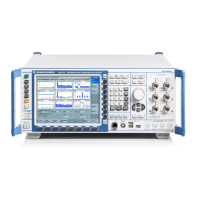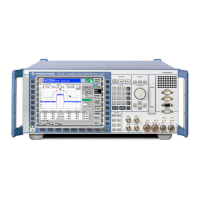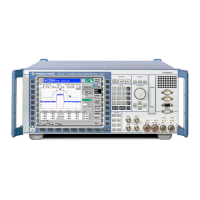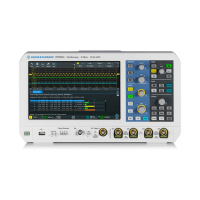System Overview
R&S
®
CMW500
52User Manual 1173.9463.02 ─ 06
"Generator pending" state
Depending on the generator type and configuration, the R&S CMW500 may require some
time to provide the generator signal. E.g. the ARB generator signal is available only after
a waveform file has been loaded:
While the generator is turned on but still waiting for resource allocation, adjustment,
hardware switching, a yellow sandglass symbol in the generator control softkey indicates
the "generator pending" state.
The yellow symbol disappears as soon as the generator signal is available.
The "pending" state is also indicated while the generator is turned off but the resources
have not yet been released.
3.1.2 RF Path Settings (Generators)
The R&S CMW500 provides a number of settings that are very similar in different gen-
erators but can be configured independently. These settings control the routing of signals
and the generator level.
Signal Routing Settings (Output)
The R&S CMW500 provides several RF connectors at the front panel. The RF output
connector and the TX module to be used are selected in the "RF Routing" section at the
beginning of the generator configuration dialogs.
External Attenuation (Output)
Defines the value of an external attenuation (or gain, if the value is negative) in the output
path. This is suitable if the RF generator is to compensate for the effect of a frequency-
independent attenuating component in the test setup (e.g. a non-ideal cable, a test fixture
or an RF shielding chamber used to hold the DUT), or an amplifier.
Additional settings for compensation of a frequency-dependent attenuation/gain are pro-
vided by the base system of the instrument. They allow to define correction tables con-
taining pairs of frequencies and associated attenuation/gain values.
If a table is activated for an output connector, the correction value associated with the
current carrier frequency and the frequency-independent "External Attenuation" defined
in the generator settings are added. Correction values for intermediate frequencies
between two frequency entries are calculated using linear interpolation. For frequencies
higher than the highest frequency entry in the table, or lower than the lowest frequency
entry, the correction value associated with the highest / lowest frequency entry is used.
Generators
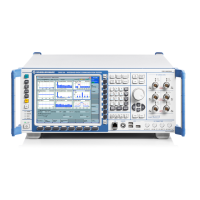
